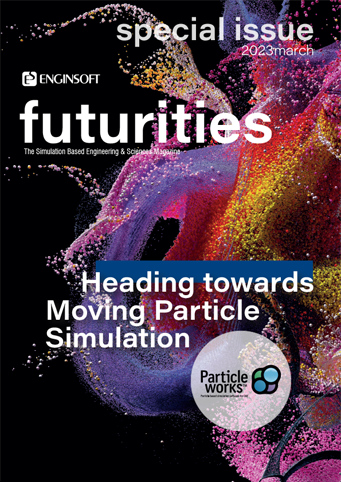Particleworks
Effizienz steigern und Kosten sparen
Particleworks ist ein Produkt der Prometech Software, Inc.
Particleworks ist ein Produkt der Prometech Software, Inc.
Die Gittergenerierung bei der numerischen Strömungssimulation (Computational Fluid Dynamics - CFD) ist ein sehr aufwendiger Prozess, der mehrere Wochen in Anspruch nehmen kann. Auch die Berechnung der instationären Strömung selbst bringt einen großen Zeitaufwand mit sich. Diese enormen Zeitaufwände lassen sich aufgrund der immer kürzer getakteten Time-to-Market-Intervalle und verkürzten Produktentstehungszyklen heutzutage kaum noch umsetzen.
Particleworks greift diese Probleme mit seiner Moving Particle Simulation (MPS) Methode auf und ermöglicht dank der implementierten vernetzungsfreien Methodik eine Aufwandsreduktion von fast 90%. Die vielfältigen Anwendungsgebiete erlauben es, innerhalb kürzester Zeit detaillierte Berechnungen durchzuführen und Ihre CFD-Projekte grundlegend zu optimieren. Der Wegfall der Netzerstellung bei der Strömungssimulation in Particleworks lässt die Produktentstehung nicht nur kostengünstiger und effizienter ausfallen, sondern überzeugt auch durch eine deutlich verbesserte Benutzeroberfläche, vereinfachte Handhabung und anschauliche Visualisierungsoptionen.
Particleworks ist eine Strömungssimulations-Software (CFD-Software), die auf der innovativen numerischen Methode der Moving Particle Simulation (MPS) beruht. Particleworks wird von EnginSoft europaweit unterstützt und vertrieben und bietet durch den Wegfall des Vernetzungsprozesses in der Methodik signifikante Einsparmöglichkeit in den Turnaround-Zeiten der Simulationen und damit auch in den Entwicklungskosten. Für konventionelle CFD-Tools schwierige Fragestellungen, wie Free-Surface Flows, lassen sich mit Particleworks ohne Einsatz übermäßiger Rechnerressourcen beantworten. Für CFD-Anwender bietet Particleworks einen robusten und intuitiven Workflow und trägt so zu einem effizienteren CAE-Prozess bei. Schlussendlich kann durch diese MPS-Software die notwenige Anzahl physischer Prototypen auf ein Minimum reduziert, und somit Kosten gespart werden.
Fordern Sie eine kostenlose Demo anbrochure

Moving Particle Simulation (MPS) is a meshless method of Computational Fluid Dynamics (CFD) specifically conceived to analyse liquid flows, from the most common liquids like water and oil, to the most complex ones such as highly viscous consumer products, adhesives, polymers, and foods or even semi-solid materials like grease or organic waste.
This publication is a collection of papers addressing different industrial sectors and covering applications ranging from lubrication of transmissions, cooling of engines, prevention of aquaplaning, and fire extinguishing, to the electrification of mobility solutions and the study of snow drifts.
Particleworks

Stellen Sie unseren Experten jetzt Ihre technischen Fragen!!
Über dieses Formular treten Sie direkt mit einem EnginSoft Experten in Kontakt, der Ihnen eine zuverlässige Antwort auf Ihre Frage geben und eine passende Lösung empfehlen kann.
CASE STUDY
Transmission design is mainly based on the mechanical aspects of the transmission and lubrication is an aspect that is verified, and eventually corrected, based on bench testing, i.e. once the design phase has been completed and a physical prototype is available.
mechanics particleworks automotive

CASE STUDY
In this technical article, we demonstrate how to apply a one-way coupling technique using a combination of ParticleWorks and LS-DYNA to estimate tsunami damage to a vehicle.
automotive ls-dyna energy cfd particleworks environmental
CASE STUDY
This paper presents the preliminary simulation study of a typical centrifuge currently produced by Gamma Meccanica. The objective of this study is to evaluate the behaviour of the centrifuge using moving particle simulation and discrete element method (MPS-DEM) simulation techniques with Particleworks 7.2.1 to gain a better understanding of phenomena that are impossible to monitor experimentally.
mechanics particleworks
CASE STUDY
Designing efficient, grease-lubricated gearboxes—particularly for high-load applications like steering drives—presents unique engineering challenges. SPN Schwaben Präzision, in collaboration with EnginSoft GmbH, uses advanced simulation tools to optimize gearbox lubrication, focusing on lifetime performance and minimal maintenance. Grease offers advantages such as long-term stability and effective adhesion but requires precise control of quantity and targeted distribution to prevent wear or overheating.
particleworks cfd
CASE STUDY
Motorsport’s competitive demands drive innovation, such as optimizing fuel tank performance by reducing sloshing and ensuring efficient fuel extraction. This study explores a meshless CFD approach using Moving Particle Simulation (MPS) to streamline workflows and reduce computational costs compared to traditional finite volume method (FVM) CFD.
automotive cfd particleworks